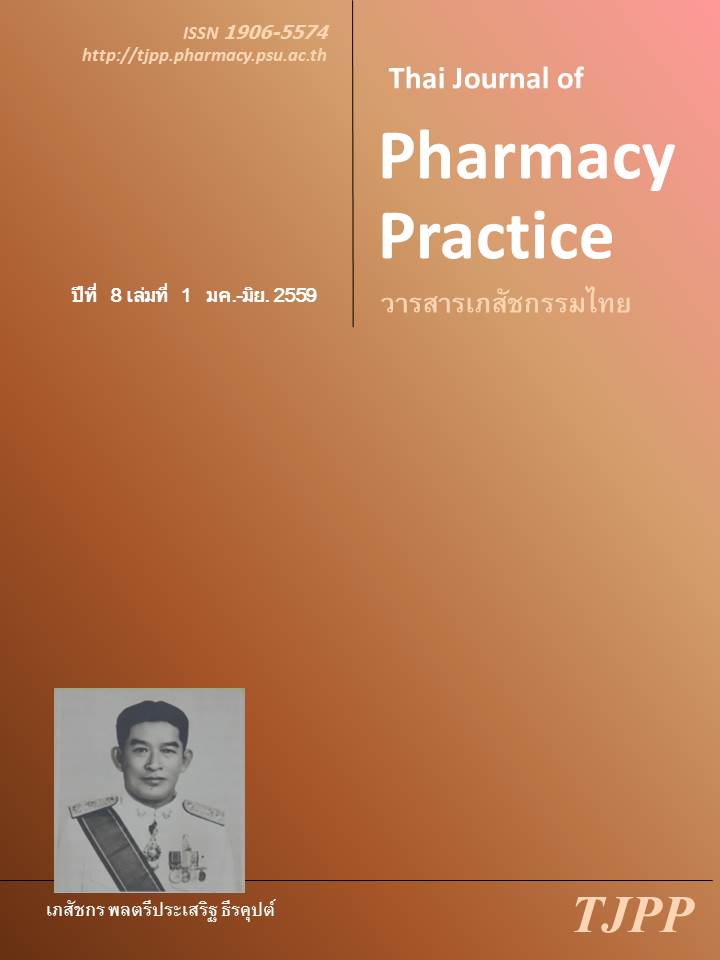การเฝ้าระวังและจัดการกับการโฆษณาที่ฝ่าฝืนพระราชบัญญัติเครื่องสำอาง โดยสำนักงานคณะกรรมการอาหารและยาในปีงบประมาณ 2554-2558
Main Article Content
บทคัดย่อ
วัตถุประสงค์: เพื่อศึกษาความชุกของการโฆษณาเครื่องสำอางที่ฝ่าฝืนกฎหมายที่พบจากการเฝ้าระวังของสำนักงานคณะกรรมการอาหารและยา (อย.) ในปีงบประมาณ 2554-2558 และศึกษาถึงผลการดำเนินคดี ตลอดจนลักษณะข้อความโฆษณาที่ฝ่าฝืนกฎหมาย วิธีการ: การศึกษานี้เป็นการวิจัยเอกสาร โดยช่วงแรกเป็นการรวบรวมข้อมูลจากเอกสารที่เกี่ยวข้องกับการโฆษณาเครื่องสำอางจากสำนักควบคุมเครื่องสำอางและวัตถุอันตราย ของ อย. ในช่วง 5 ปีงบประมาณที่ศึกษา โดยเฉพาะอย่างยิ่งเอกสารเกี่ยวกับผลการตรวจสอบโฆษณาของ อย. และการดำเนินคดีด้านโฆษณาเครื่องสำอางซึ่งเลขาธิการคณะกรรมการอาหารและยามีคำสั่งเปรียบเทียบปรับ ช่วงที่สองของการศึกษาเป็นจัดประชุมระดมสมองผู้เชี่ยวชาญเพื่อตรวจสอบความถูกต้องของข้อมูล และวิเคราะห์เพื่อหาข้อสรุปเกี่ยวกับการโฆษณาเครื่องสำอางที่ฝ่าฝืนกฎหมายในมิติต่าง ๆ ผู้วิจัยใช้การวิเคราะห์เนื้อหาเพื่อสรุปเกี่ยวกับลักษณะข้อความที่ฝ่าฝืนกฎหมาย ผลการวิจัย: การตรวจสอบโฆษณาเครื่องสำอางของ อย. ใน 5 ปีงบประมาณที่ศึกษา จำนวน 63,266 รายการ พบการโฆษณาที่ไม่ถูกต้องร้อยละ 0.54 สื่อวิทยุ สื่อโทรทัศน์ และสื่ออินเทอร์เน็ตมีการโฆษณาที่ผิดกฎหมาย ร้อยละ 3.81 1.27 และ 0.91 ของจำนวนชิ้นโฆษณาที่ตรวจสอบตามลำดับ การดำเนินคดี 181 คดีเกี่ยวข้องกับผู้ประกอบธุรกิจเครื่องสำอาง 179 รายและผู้ประกอบกิจการโฆษณา 172 ราย จำนวนชิ้นโฆษณาเครื่องสำอางที่ถูกดำเนินคดีเป็นการโฆษณาทางนิตยสาร อินเทอร์เน็ต และโทรทัศน์ร้อยละ 57.46 22.81 10.09 ตามลำดับ ผู้กระทำความผิดถูกเปรียบเทียบปรับรวม 351 ราย ในช่วง 5 ปีที่ศึกษา พบว่ามีผู้ไม่มาชำระค่าปรับซึ่งต้องดำเนินคดีทางศาลร้อยละ 53.57 ของผู้กระทำความผิด เมื่อจำแนกความผิดตามบทบัญญัติแห่งพระราชบัญญัติเครื่องสำอาง พ.ศ. 2558 พบว่า ฝ่าฝืนมาตรา 41(2) โดยแสดงข้อความที่จะก่อให้เกิดความเข้าใจผิดในสาระสำคัญเกี่ยวกับเครื่องสำอางร้อยละ 46.06 ข้อความโฆษณาที่ฝ่าฝืนกฎหมายสามารถแบ่งได้ 4 กลุ่ม ดังนี้ 1. ข้อความที่ทำให้เข้าใจได้ว่าผลิตภัณฑ์มีผลต่อโครงสร้างหรือการทำงานของระบบภายในร่างกาย ซึ่งเป็นสรรพคุณทางยา 2. ข้อความที่มีวัตถุประสงค์ในการใช้ที่ไม่จัดเป็นเครื่องสำอาง 3. การโฆษณาที่ยังไม่สามารถพิสูจน์ความจริงตามข้อความโฆษณา และ 4. ข้อความที่ไม่เหมาะสม เกินจริง หรือเป็นเท็จ สรุป: ผลจากการศึกษาในครั้งนี้สามารถนำไปจัดทำคู่มือแนวการพิจารณาโฆษณาเครื่องสำอาง ตามพระราชบัญญัติเครื่องสำอาง พ.ศ. 2558 เพื่อคุ้มครองผู้บริโภคด้านโฆษณาต่อไป
Article Details
ผลการวิจัยและความคิดเห็นที่ปรากฏในบทความถือเป็นความคิดเห็นและอยู่ในความรับผิดชอบของผู้นิพนธ์ มิใช่ความเห็นหรือความรับผิดชอบของกองบรรณาธิการ หรือคณะเภสัชศาสตร์ มหาวิทยาลัยสงขลานครินทร์ ทั้งนี้ไม่รวมความผิดพลาดอันเกิดจากการพิมพ์ บทความที่ได้รับการเผยแพร่โดยวารสารเภสัชกรรมไทยถือเป็นสิทธิ์ของวารสารฯ
เอกสารอ้างอิง
2. National Science and Technology Development Agency. Cosmetics and cosmeceuticals industry [online]. 2015 [cited Oct 12, 2015]. Available from: www.technology.in.th/industrial-data/doku.php?Id= cosmetics-industry:newstart-introduction
3. Digital Advertising Association (Thailand). Trends in digital advertising 2014-2015 [online]. 2015 [cited Oct 13, 2015]. Available from: thumbsup .in.th/2015/03/daat-direction-digital-advertising-thai land-2014-2015/
4. Cosmetic Act B.E. 2535. Royal Gazette No. 109, Part 42 (Apr 8, 1992).
5. Cosmetic Act B.E. 2558. Royal Gazette No. 132, Part 86A (Sep 8, 2015).
6. Rujirayunyong T. Situation of illegal advertising of health products among local radios in Lopburi in the era of the National Council for Peace and Order (NCPO). Thai Journal of Pharmacy Practice 2015; 7:187-95.
7. Suwanmanee O, Lerkiatbundit S. Illegal advertising of products classified as drugs by law among local radios. Thai Journal of Pharmacy Practice 2011;3: 41-56.
8. Declaration of Prime Minister Office on appointments of competent officers for the execution of the Consumer Protection Act, B.E. 2522. (Jul 16, 2010).
9. Declaration of Prime Minister Office on the correction of the Declaration on appointments of competent officers for the execution of the Consumer Protection Act, B.E. 2522. (Sep 28, 2010).
10. Directive of Consumer Protection Committee no 7/2553 on authorization of competent officers to settle the case according to of the Consumer Protection Act, B.E. 2522. (Jul 16, 2010).
11. Directive of Consumer Protection Committee no 8/2553 on Directive on the correction of the authorization of competent officers to settle the case according to of the Consumer Protection Act, B.E. 2522. (Sep 28, 2010).
12. The fourth National Health Assembly. Eradication of unlawful advertising of drugs, foods, and health products on radios, televisions and internet [online]. 2015 [cited Oct 12, 2015]. Available from: nha2011.samatcha.org/sites/default/files/7res5_food& drug_ advertising.pdf.
13. Consumer Protection Act B.E. 2522. Royal Gazette No. 96, Part 72A special (May 4, 1979).
14. Marketeer Magazine. Online advertising as an answer for advertising budgeting among businessmen, 40-52% growth of expenditures for online advertising expected in 2016 [online]. 2015 [cited Oct 13, 2015]. Available from: marketeer.co .th/2016/01/69345/.
15. Cosmetics and Hazardous Substances Control Bureau. Guidelines on the monitoring of cosmetics advertising. Nonthaburi: Food and Drug Adminis- tration; 2011.
16. Cosmetics and Hazardous Substances Control Bureau. ASEAN cosmetic document: Appendix III-ASEAN cosmetic claim guideline. Nonthaburi: Food and Drug Administration; 2007.
17. Cosmetics and Hazardous Substances Control Bureau. Guidelines for approving advertising messages for cosmetics. Nonthaburi: Food and Drug Administration; 1996.
18. Cosmetics and Hazardous Substances Control Bureau. Penalty fines to settle the cases on cosmetics advertising. Nonthaburi: Food and Drug Administration; 2008.
19. Cosmetics and Hazardous Substances Control Bureau. Bureau ‘s report on the fiscal year 2011-2015. Nonthaburi: Food and Drug Administration; 2015.
20. Kutchamas S. Cosmetics advertising. Medicinal and Health Product Bulletin 2013; 16: 24-8.
21. Cosmetics and Hazardous Substances Control Bureau. Guidelines for controlling cosmetics advertising. Nonthaburi: Food and Drug Adminis- tration; 2014.
22. Pandech A. Cooperation for stopping illegal advertising of health products with FDA. Yawipak 2014; 6: 10-11


